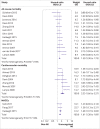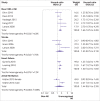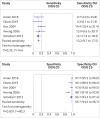Prognosis of unrecognised myocardial infarction determined by electrocardiography or cardiac magnetic resonance imaging: systematic review and meta-analysis
- PMID: 32381490
- PMCID: PMC7203874
- DOI: 10.1136/bmj.m1184
Prognosis of unrecognised myocardial infarction determined by electrocardiography or cardiac magnetic resonance imaging: systematic review and meta-analysis
Abstract
Objective: To evaluate the prognosis of unrecognised myocardial infarction determined by electrocardiography (UMI-ECG) or cardiac magnetic resonance imaging (UMI-CMR).
Design: Systematic review and meta-analysis of prospective studies.
Data sources: Electronic databases, including PubMed, Embase, and Google Scholar.
Study selection: Prospective cohort studies were included if they reported adjusted relative risks, odds ratios, or hazard ratios and 95% confidence intervals for all cause mortality or cardiovascular outcomes in participants with unrecognised myocardial infarction compared with those without myocardial infarction.
Data extraction and synthesis: The primary outcomes were composite major adverse cardiac events, all cause mortality, and cardiovascular mortality associated with UMI-ECG and UMI-CMR. The secondary outcomes were the risks of recurrent coronary heart disease or myocardial infarction, stroke, heart failure, and atrial fibrillation. Pooled hazard ratios and 95% confidence intervals were reported. The heterogeneity of outcomes was compared in clinically recognised and unrecognised myocardial infarction.
Results: The meta-analysis included 30 studies with 253 425 participants and 1 621 920 person years of follow-up. UMI-ECG was associated with increased risks of all cause mortality (hazard ratio 1.50, 95% confidence interval 1.30 to 1.73), cardiovascular mortality (2.33, 1.66 to 3.27), and major adverse cardiac events (1.61, 1.38 to 1.89) compared with the absence of myocardial infarction. UMI-CMR was also associated with increased risks of all cause mortality (3.21, 1.43 to 7.23), cardiovascular mortality (10.79, 4.09 to 28.42), and major adverse cardiac events (3.23, 2.10 to 4.95). No major heterogeneity was observed for any primary outcomes between recognised myocardial infarction and UMI-ECG or UMI-CMR. The absolute risk differences were 7.50 (95% confidence interval 4.50 to 10.95) per 1000 person years for all cause mortality, 11.04 (5.48 to 18.84) for cardiovascular mortality, and 27.45 (17.1 to 40.05) for major adverse cardiac events in participants with UMI-ECG compared with those without myocardial infarction. The corresponding data for UMI-CMR were 32.49 (6.32 to 91.58), 37.2 (11.7 to 104.20), and 51.96 (25.63 to 92.04), respectively.
Conclusions: UMI-ECG or UMI-CMR is associated with an adverse long term prognosis similar to that of recognised myocardial infarction. Screening for unrecognised myocardial infarction could be useful for risk stratification among patients with a high risk of cardiovascular disease.
© Author(s) (or their employer(s)) 2019. Re-use permitted under CC BY-NC. No commercial re-use. See rights and permissions. Published by BMJ.
Conflict of interest statement
Competing interests: All authors have completed the ICMJE uniform disclosure form at www.icmje.org/coi_disclosure.pdf and declare: support from the National Natural Science Foundation of China, Science and Technology Innovation Project from Foshan, Guangdong, and Shunde Hospital, Southern Medical University for the submitted work; no financial relationships with any organisations that might have an interest in the submitted work in the previous three years; no other relationships or activities that could appear to have influenced the submitted work.
Figures






Similar articles
-
Prevalence and prognosis of unrecognized myocardial infarction determined by cardiac magnetic resonance in older adults.JAMA. 2012 Sep 5;308(9):890-6. doi: 10.1001/2012.jama.11089. JAMA. 2012. PMID: 22948699 Free PMC article.
-
Late gadolinium enhancement is a risk factor for major adverse cardiac events in unrecognised myocardial infarction without apparent symptoms: a meta-analysis.Clin Radiol. 2021 Jan;76(1):79.e1-79.e11. doi: 10.1016/j.crad.2020.07.038. Epub 2020 Oct 1. Clin Radiol. 2021. PMID: 33012499
-
Association of Unrecognized Myocardial Infarction With Long-term Outcomes in Community-Dwelling Older Adults: The ICELAND MI Study.JAMA Cardiol. 2018 Nov 1;3(11):1101-1106. doi: 10.1001/jamacardio.2018.3285. JAMA Cardiol. 2018. PMID: 30304454 Free PMC article.
-
Meta-analysis of adverse cardiovascular outcomes associated with antecedent hypertension after myocardial infarction.Am J Cardiol. 2009 Jul 1;104(1):141-7. doi: 10.1016/j.amjcard.2009.02.048. Epub 2009 May 4. Am J Cardiol. 2009. PMID: 19576336 Review.
-
Impact of periprocedural myocardial injury on long-term clinical outcomes of chronic total occlusion patients undergoing percutaneous coronary intervention: a systematic review and meta-analysis.Coron Artery Dis. 2020 May;31(3):208-214. doi: 10.1097/MCA.0000000000000813. Coron Artery Dis. 2020. PMID: 31703014 Free PMC article.
Cited by
-
α-Linolenic Acid and Risk of Heart Failure: A Meta-Analysis.Front Cardiovasc Med. 2022 Jan 4;8:788452. doi: 10.3389/fcvm.2021.788452. eCollection 2021. Front Cardiovasc Med. 2022. PMID: 35059448 Free PMC article.
-
A hybrid algorithm-based ECG risk prediction model for cardiovascular disease.Eur Heart J Digit Health. 2025 Mar 19;6(3):466-475. doi: 10.1093/ehjdh/ztaf023. eCollection 2025 May. Eur Heart J Digit Health. 2025. PMID: 40395411 Free PMC article.
-
Myocardial fibrosis and prognosis in heart failure with preserved ejection fraction: a pooled analysis of 12 cohort studies.Eur Radiol. 2024 Mar;34(3):1854-1862. doi: 10.1007/s00330-023-10218-w. Epub 2023 Sep 2. Eur Radiol. 2024. PMID: 37658896
-
Myocardial Damage Patterns in Patients with Left Ventricular Systolic Dysfunction with and Without Coronary Artery Disease Referred for Cardiac Magnetic Resonance.Biomedicines. 2025 Jul 1;13(7):1612. doi: 10.3390/biomedicines13071612. Biomedicines. 2025. PMID: 40722685 Free PMC article.
-
Association Between Hemoglobin Glycation Index and Risk of Cardiovascular Disease and All Cause Mortality in Type 2 Diabetic Patients: A Meta-Analysis.Front Cardiovasc Med. 2021 May 28;8:690689. doi: 10.3389/fcvm.2021.690689. eCollection 2021. Front Cardiovasc Med. 2021. PMID: 34124211 Free PMC article.
References
Publication types
MeSH terms
LinkOut - more resources
Full Text Sources
Medical
